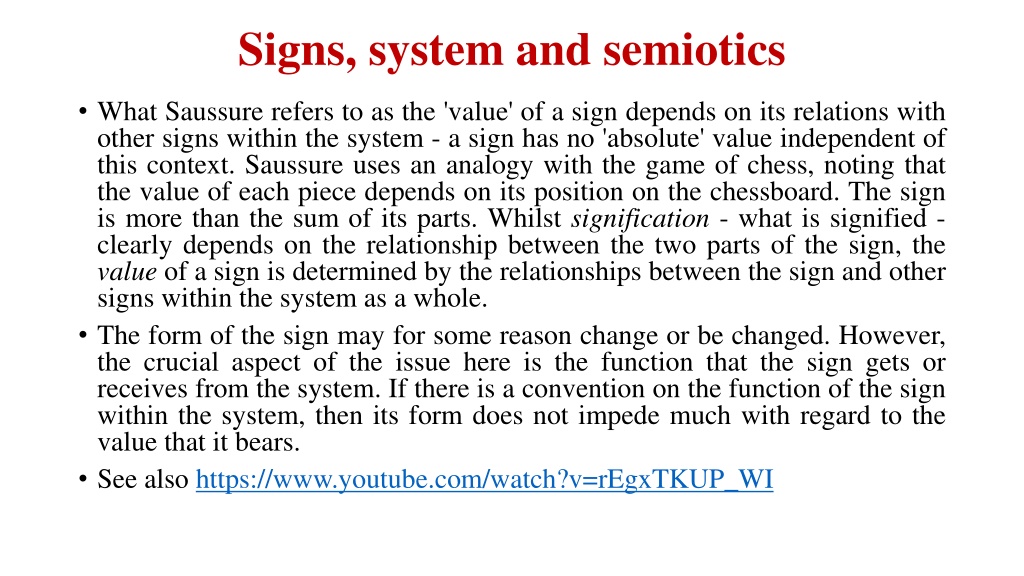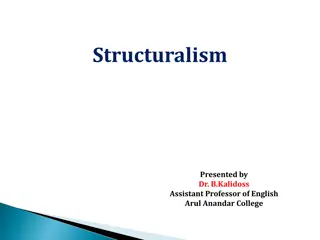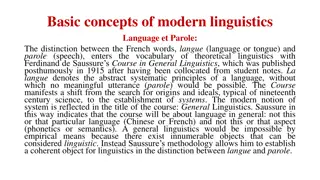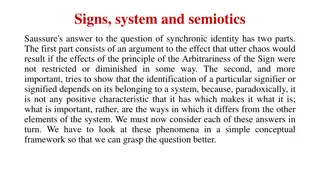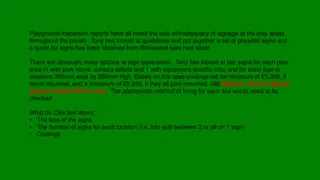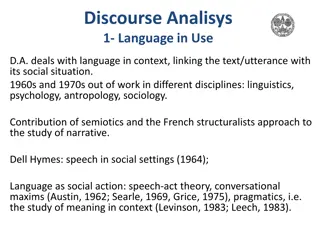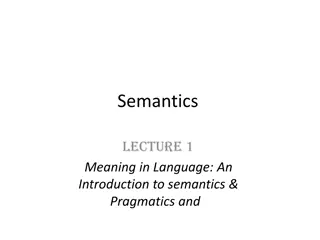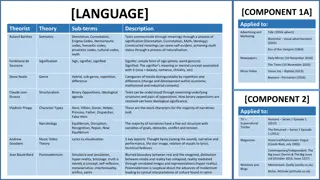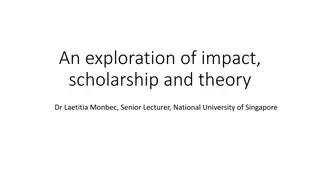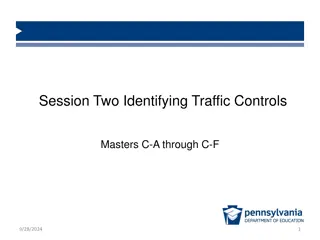Understanding Signs, System, and Semiotics According to Saussure
Saussure's concept of sign value emphasizes the importance of relationships within a system, where a sign's meaning is not absolute but dependent on its interactions with other signs. He highlights the distinction between signification and value, showcasing how signs derive their value from the system as a whole. The relational identity of signs forms the basis of structuralist theory, focusing on functional differences and oppositions. Saussure's analysis underscores the significance of binary oppositions in understanding signs and their value within a system.
Download Presentation

Please find below an Image/Link to download the presentation.
The content on the website is provided AS IS for your information and personal use only. It may not be sold, licensed, or shared on other websites without obtaining consent from the author. Download presentation by click this link. If you encounter any issues during the download, it is possible that the publisher has removed the file from their server.
E N D
Presentation Transcript
Signs, system and semiotics What Saussure refers to as the 'value' of a sign depends on its relations with other signs within the system - a sign has no 'absolute' value independent of this context. Saussure uses an analogy with the game of chess, noting that the value of each piece depends on its position on the chessboard. The sign is more than the sum of its parts. Whilst signification - what is signified - clearly depends on the relationship between the two parts of the sign, the value of a sign is determined by the relationships between the sign and other signs within the system as a whole. The form of the sign may for some reason change or be changed. However, the crucial aspect of the issue here is the function that the sign gets or receives from the system. If there is a convention on the function of the sign within the system, then its form does not impede much with regard to the value that it bears. See also https://www.youtube.com/watch?v=rEgxTKUP_WI
Signs, value in a system and semiotics The notion of value... shows us that it is a great mistake to consider a sign as nothing more than the combination of a certain sound and a certain concept. To think of a sign as nothing more would be to isolate it from the system to which it belongs. It would be to suppose that a start could be made with individual signs, and a system constructed by putting them together. On the contrary, the system as a united whole is the starting point, from which it becomes possible, by a process of analysis, to identify its constituent elements. As an example of the distinction between signification and value, Saussure notes that 'The French word mouton may have the same meaning as the English word sheep; but it does not have the same value. There are various reasons for this, but in particular the fact that the English word for the meat of this animal, as prepared and served for a meal, is not sheep but mutton. The difference in value between sheep and mouton hinges on the fact that in English there is also another word mutton for the meat, whereas mouton in French covers both'.
Signs, value in a system and semiotics Saussure's relational conception of meaning was specifically differential: he emphasized the differences between signs. Language for him was a system of functional differences and oppositions. 'In a language, as in every other semiological system, what distinguishes a sign is what constitutes it'. As John Sturrock points out, 'a one-term language is an impossibility because its single term could be applied to everything and differentiate nothing; it requires at least one other term to give it definition'. Advertising furnishes a good example of this notion, since what matters in 'positioning' a product is not the relationship of advertising signifiers to real-world referents, but the differentiation of each sign from the others to which it is related. Saussure's concept of the relational identity of signs is at the heart of structuralist theory. Structuralist analysis focuses on the structural relations which are functional in the signifying system at a particular moment in history. 'Relations are important for what they can explain: meaningful contrasts and permitted or forbidden combinations'.
Signs, dichotomy and value in a system Saussure emphasized in particular negative, oppositional differences between signs, and the key relationships in structuralist analysis are binary oppositions (such as nature/culture, life/death). Saussure argued that 'concepts... are defined not positively, in terms of their content, but negatively by contrast with other items in the same system. What characterizes each most exactly is being whatever the others are not'. This notion may initially seem mystifying if not perverse, but the concept of negative differentiation becomes clearer if we consider how we might teach someone who did not share our language what we mean by the term 'red'. We would be unlikely to make our point by simply showing them a range of different objects which all happened to be red - we would be probably do better to single out a red object from a sets of objects which were identical in all respects except colour. Although Saussure focuses on speech, he also noted that in writing, 'the values of the letter are purely negative and differential' - all we need to be able to do is to distinguish one letter from another. As for his emphasis on negative differences, Saussure remarks that although both the signified and the signifier are purely differential and negative when considered separately, the sign in which they are combined is a positive term. He adds that 'the moment we compare one sign with another as positive combinations, the term difference should be dropped... Two signs... are not different from each other, but only distinct. They are simply in opposition to each other. The entire mechanism of language... is based on oppositions of this kind and upon the phonic and conceptual differences they involve .
Signs and value in a system Although the signifier is treated by its users as 'standing for' the signified, Saussurean semioticians emphasize that there is no necessary, intrinsic, direct or inevitable relationship between the signifier and the signified. Saussure stressed the arbitrariness of the sign - more specifically the arbitrariness of the link between the signifier and the signified. He was focusing on linguistic signs, seeing language as the most important sign system; for Saussure, the arbitrary nature of the sign was the first principle of language - arbitrariness was identified later by Charles Hockett as a key 'design feature' of language. The feature of arbitrariness may indeed help to account for the extraordinary versatility of language. In the context of natural language, Saussure stressed that there is no inherent, essential, 'transparent', self-evident or 'natural' connection between the signifier and the signified - between the sound or shape of a word and the concept to which it refers. Note that Saussure himself avoids directly relating the principle of arbitrariness to the relationship between language and an external world, but that subsequent commentators often do, and indeed, lurking behind the purely conceptual 'signified' one can often detect Saussure's allusion to real-world referents. In language at least, the form of the signifier is not determined by what it signifies: there is nothing 'treeish' about the word 'tree'. Languages differ, of course, in how they refer to the same referent. No specific signifier is 'naturally' more suited to a signified than any other signifier; in principle any signifier could represent any signified. Saussure observed that 'there is nothing at all to prevent the association of any idea whatsoever with any sequence of sounds whatsoever'; 'the process which selects one particular sound-sequence to correspond to one particular idea is completely arbitrary'.
Arbitrariness This principle of the arbitrariness of the linguistic sign was not an original conception: Aristotle had noted that 'there can be no natural connection between the sound of any language and the things signified'. In Plato's Cratylus Hermogenes urged Socrates to accept that 'whatever name you give to a thing is its right name; and if you give up that name and change it for another, the later name is no less correct than the earlier, just as we change the name of our servants; for I think no name belongs to a particular thing by nature'. 'That which we call a rose by any other name would smell as sweet', as Shakespeare put it. Whilst the notion of the arbitrariness of language was not new, but the emphasis which Saussure gave it can be seen as an original contribution, particularly in the context of a theory which bracketed the referent. Note that although Saussure prioritized speech, he also stressed that 'the signs used in writing are arbitrary, The letter t, for instance, has no connection with the sound it denotes'
Arbitrariness The arbitrariness of the sign is a radical concept because it proposes the autonomy of language in relation to reality. The Saussurean model, with its emphasis on internal structures within a sign system, can be seen as supporting the notion that language does not 'reflect' reality but rather constructs it. We can use language 'to say what isn't in the world, as well as what is. And since we come to know the world through whatever language we have been born into the midst of, it is legitimate to argue that our language determines reality, rather than reality our language . In their book The Meaning of Meaning, Ogden and Richards criticized Saussure for 'neglecting entirely the things for which signs stand . Later critics have lamented his model's detachment from social context. Robert Stam argues that by 'bracketing the referent', the Saussurean model 'severs text from history'. We will return to this theme of the relationship between language and 'reality' in our discussion of 'modality and representation . The arbitrary aspect of signs does help to account for the scope for their interpretation (and the importance of context). There is no one-to-one link between signifier and signified; signs have multiple rather than single meanings. Within a single language, one signifier may refer to many signifieds (e.g. puns) and one signified may be referred to by many signifiers (e.g. synonyms). Some commentators are critical of the stance that the relationship of the signifier to the signified, even in language, is always completely arbitrary. Onomatopoeic words are often mentioned in this context, though some semioticians retort that this hardly accounts for the variability between different languages in their words for the same sounds (notably the sounds made by familiar animals).
Arbitrariness The arbitrariness principle can be applied not only to the sign, but to the whole sign-system. The fundamental arbitrariness of language is apparent from the observation that each language involves different distinctions between one signifier and another (e.g. 'tree' and 'free') and between one signified and another (e.g. 'tree' and 'bush'). The signified is clearly arbitrary if reality is perceived as a seamless continuum (which is how Saussure sees the initially undifferentiated realms of both thought and sound): where, for example, does a 'corner' end? Commonsense suggests that the existence of things in the world preceded our apparently simple application of 'labels' to them (a 'nomenclaturist' notion which Saussure rejected and to which we will return in due course). Saussure noted that 'if words had the job of representing concepts fixed in advance, one would be able to find exact equivalents for them as between one language and another. But this is not the case . Reality is divided up into arbitrary categories by every language and the conceptual world with which each of us is familiar could have been divided up very differently. Indeed, no two languages categorize reality in the same way. As John Passmore puts it, 'Languages differ by differentiating differently . Linguistic categories are not simply a consequence of some predefined structure in the world. There are no 'natural' concepts or categories which are simply 'reflected' in language. Language plays a crucial role in 'constructing reality'.
Signs, Saussure and Lacan If one accepts the arbitrariness of the relationship between signifier and signified then one may argue counter- intuitively that the signified is determined by the signifier rather than vice versa. Indeed, the French psychoanalyst Jacques Lacan, in adapting Saussurean theories, sought to highlight the primacy of the signifier in the psyche by rewriting Saussure's model of the sign in the form of a quasi-algebraic sign in which a capital 'S' (representing the signifier) is placed over a lower case and italicized 's' (representing the signified), these two signifiers being separated by a horizontal 'bar'. This suited Lacan's purpose of emphasizing how the signified inevitably 'slips beneath' the signifier, resisting our attempts to delimit it. Lacan poetically refers to Saussure's illustration of the planes of sound and thought as 'an image resembling the wavy lines of the upper and lower Waters in miniatures from manuscripts of Genesis; a double flux marked by streaks of rain', suggesting that this can be seen as illustrating the 'incessant sliding of the signified under the signifier' - although he argues that one should regard the dotted vertical lines not as 'segments of correspondence' but as 'anchoring points' (points de capiton - literally, the 'buttons' which anchor upholstery to furniture). However, he notes that this model is too linear, since 'there is in effect no signifying chain that does not have, as if attached to the punctuation of each of its units, a whole articulation of relevant contexts suspended 'vertically', as it were, from that point'. In the spirit of the Lacanian critique of Saussure's model, subsequent theorists have emphasized the temporary nature of the bond between signifier and signified, stressing that the 'fixing' of 'the chain of signifiers' is socially situated. Note that whilst the intent of Lacan in placing the signifier over the signified is clear enough, his representational strategy seems a little curious, since in the modelling of society orthodox Marxists routinely represent the fundamental driving force of 'the [techno-economic] base' as (logically) below 'the [ideological] superstructure'.
References http://visual-memory.co.uk/daniel/Documents/S4B/sem02.html by Daniel Chandler Holcroft, David. 1991. Saussure, Signs, System andArbitrariness. Cambridge: CUP.
